Hydrangea Confetti - characteristic of the variety
Panicle hydrangea Confetti (Confetti) is widely used in landscape design for the improvement of personal plots and landscaping of parks and urban areas.
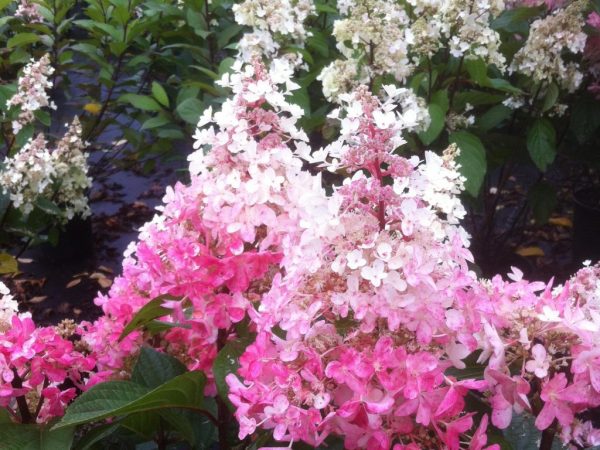
Hydrangea confetti description
Description of the variety
Hydrangea paniculata Confetti is a compactly folded ornamental crop up to 1.5 m high.
The color of the upright stems is light brown, sometimes with an orange tint. The shape of the leaves is oval, the ends are pointed, venation is clearly visible on the surface, the color is dark green.
The inflorescences are collected from rounded petals of different colors (hence the name "confetti"). Diameter - up to 30 cm, conical shape, formed by sterile (large) and fertile (small) flowers on long pedicels.
Flowering occurs from mid-summer (begins in July) to mid-autumn (including October).
Landing
Timing
The best time for planting seedlings is spring, when warm weather sets in without the risk of recurrent frosts. In warm regions, it is possible to land in open ground in September, 3-4 weeks before the expected onset of night frosts.
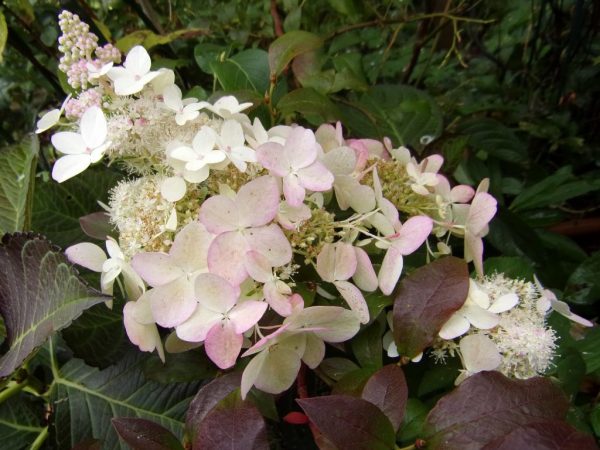
Hydrangea confetti description photo
Preparatory work
Preference should be given to moist, drained loamy soils with good air permeability and high fertility.
The required acidity is acidic, slightly acidic. Hydrangea does not tolerate the presence of limestone in the ground. On sandy soils it develops poorly or dies.
The best place will be a lit area, without direct sunlight.
Optimal soil composition:
- fertile layer - 2 parts;
- high-moor peat - 2 parts;
- leaf humus - 1 part;
- coarse sand - 1 part.
To increase the nutritional value, add urea and potassium sulfate (25 g / 10 l). In order to bring the soil to the desired acidity, pine or spruce needles are mixed.
The prepared fertile mixture is used to fill the bottom of the planting pits when planting hydrangeas.
Plants 3-4 years old are suitable for planting in open ground. The purchased seedling is inspected for rotten fragments and mold before planting. The damaged areas are cut off, the roots are soaked for 0.5 h in water and treated with a weak solution of potassium permanganate (potassium permanganate) in order to disinfect.
On one bush, from 3 or more growth buds are left.
Landing technology
After warming up the soil to 10 ° C-15 ° C, a planting pit is formed - a width of 0.7 m, a depth of about 0.4 m. The distance between lenka depends on the chosen landscape composition, but cannot be less than 1.0 m. This is the average diameter of the growth of an adult bush.
Planting stages:
- the bottom is covered with fertile soil mixture, from which a small earthen hill is formed;
- a seedling is placed in the central part and sprinkled with the remnants of nutrient soil, the voids are tamped;
- the plant is watered;
- the base of the bush is mulched with bark or ephedra with a layer 5-7 cm thick.
Care rules
Watering
The shrub prefers moist soil and does not grow well on dry soils. Optimal watering regime: once every 2 weeks. Consumption rate - about 30 l / m². Water the garden culture as the soil dries out in order to avoid excessive stagnation of water and prevent root rot.
To retain moisture near the roots of hydrangeas, they often resort to agricultural techniques - ground cover plants are planted around the perimeter.
A day after watering, it is recommended to loosen the soil near the base in order to improve aeration and ensure free passage of oxygen to the root system.
Top dressing
Starting from the second year, feeding is carried out throughout the growing season with an interval of 10-14 days:
- in the spring, nitrogen-containing compounds are introduced to activate the growth of green mass, for example, urea (20 g per 10 l);
- in the summer they are fed with manure, 10 liters per 1 bush;
- in the fall, they increase the amount of phosphorus and potash fertilizers, completely stopping the application of nitrogen.
The optimal scheme is the alternation of organics and minerals.
At the flowering stage, a stimulating top dressing is applied, mixing in equal parts 30 g of potassium sulphide, carbamide and superphosphate per 10 liters of water.
You can also use a ready-made liquid fertilizer designed specifically to feed the garden crop, alternating between root irrigation and spraying over the foliage.
Watering with kefir in the summer, 1-2 times per season, helps to maintain the required soil acid.
Watering the shrub with water with aluminum (30 g / 10 l), which affects the acidity of the soil, it is possible to change the color of the petals: whites turn blue, and pinks turn purple.
Pruning
Horticultural culture needs regular bush formation. In the spring, before the onset of sap flow, and in the fall, 2-3 weeks before the expected frost, sanitary and corrective pruning is carried out.
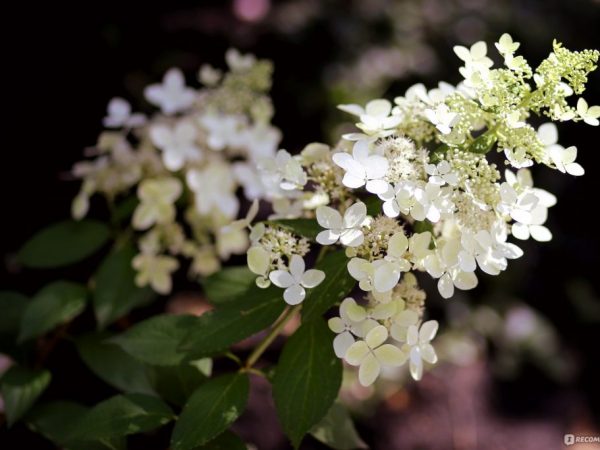
Hydrangea paniculate confetti description
Weak and damaged shoots are removed. Only healthy, strong branches are left, growing in a vertical direction. They are pruned to the growth level of well-developed buds.
Additionally, in the summer, the crown is thinned and the plant is given the desired shape, and the faded inflorescences are cut off in the fall.
Mulching
The variety is winter-hardy. Withstands a drop in temperature to -28-30 ° C. Protection of the root system from freezing in winter is necessary for young seedlings. The trunk circle is mulched.
Pre-winter preparation
When growing in unfavorable climatic regions and young seedlings, regardless of climatic conditions, they resort to warming for the winter:
- the bush is wrapped with a layer of breathable material;
- over the hydrangea, a structure is made of boards or mesh;
- the inner space is filled with dry foliage;
- the top is protected with a waterproof plastic wrap.
Such a shelter allows you to create an air microclimate around the plant and at the same time protects the stems from icing.
Reproduction methods
Paniculata hydrangea is propagated vegetatively.
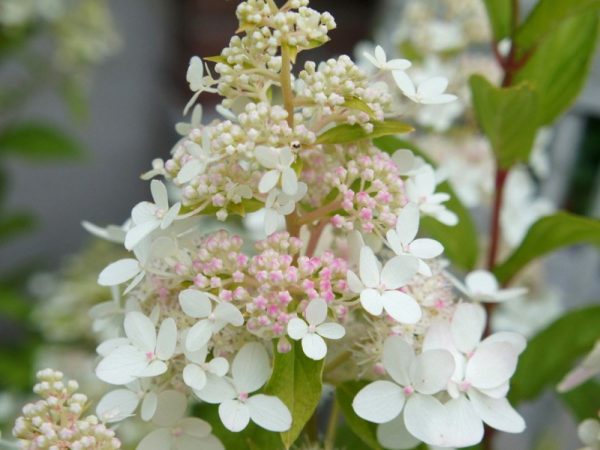
Hydrangea paniculata confetti
Cuttings
Cuttings - harvesting young shoots. The recommended cutting time is June. Cuttings are placed in water for rooting and transplanted into pots when roots appear. It is better to plant in open ground in spring.
Delenki
The division of the bush is often carried out when pruning and transplanting hydrangeas. Divide the shrub, leaving several root shoots and a stem with leaves on each part.
Layers
Shoots growing from the base are cleaned of foliage and pressed into the surface of the ground, deepening internodes.
Treatment of diseases and pests
- Spider mite. It appears initially in the lower tier, entangling foliage with brown cobwebs. As it spreads, it leads to yellowing of the vegetative mass, drying out and dropping. Contributing factors are high, about 30 ° C, temperature and average, up to 50%, moisture indicators.Sick bushes are sprayed with an insecticide, for example, Thiofos (7-10 g per 10 liters of water).
- Aphid. Most common when grown under closed conditions for forcing. The insect protes are sprayed with an aqueous solution of Anabazine sulfate (15 g per 10 l of water).
- Downy mildew. It appears as oily spots on the foliage, later they turn yellow and darken. On the stems, yellow bloom is allowed. Contributing factors are low temperature and high humidity. The vegetative mass is treated with a soap solution based on copper sulfate (150 g, 15 g per 10 l of water).
- Chlorosis. More often caused by excess humus. Brightens the color of the leaves while preserving the color of the veins. The bush is watered three times with potassium nitrate (40 g per 10 l of water), followed by a one-time watering with iron sulfate (40 g per 10 l of water).
Application in landscape design
In landscape design, it is more often grown as part of composite groups to create clumps, row plantings in combination with coniferous and herbaceous shrubs. Much less often it is used singly when planting in flower beds.
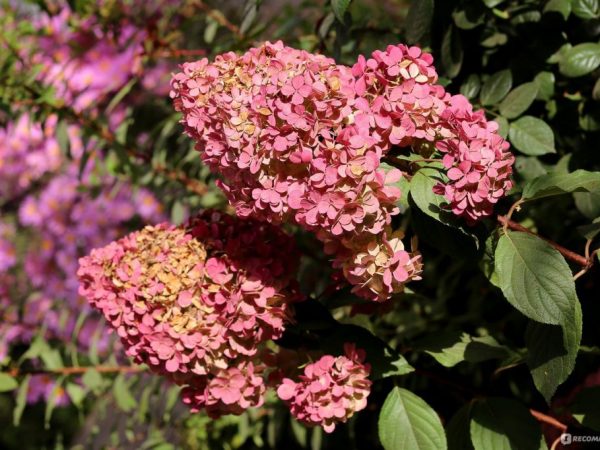
Hydrangea paniculata confetti photo
It is planted both in open ground and in containers.
Testimonials
Confetti panicle hydrangea is widely used for decorating household plots, landscaping urban areas and landscaping park areas. The winter hardiness of the crop allows it to be grown simultaneously successfully in the southern and northern regions. When cultivated in open ground, the plant needs shelter for the winter.

